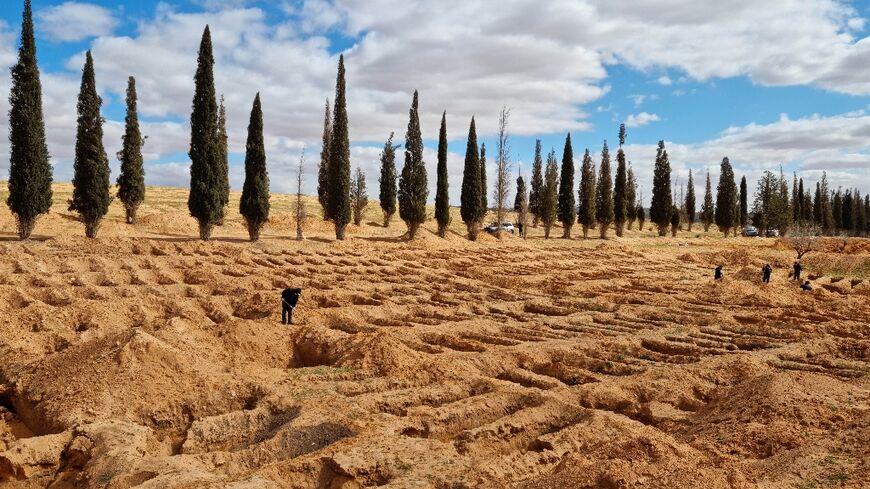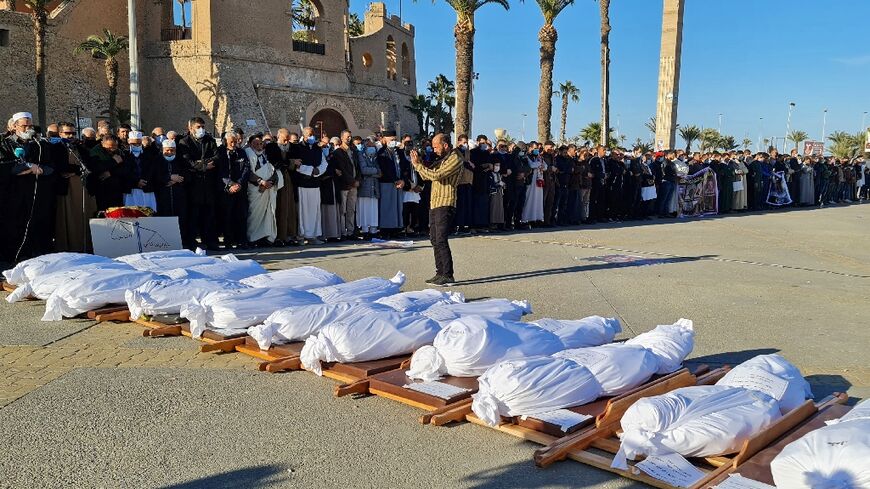

At Marin town hall, they observed a minute's silence for the victims of the tragedy, Spain's worst fishing accident in nearly 40 years
Diego URDANETA
Thu, February 17, 2022, 3:16 AM·3 min read
Flags at half-mast, black ribbons everywhere and families devastated by grief: the Spanish port town of Marin was left reeling after a deadly shipwreck left 21 sailors dead or missing at sea.
The fishing trawler which sank off eastern Canada early on Tuesday was based in this small port in Spain's northwestern Galicia region and several members of its 24-strong crew lived here.
"All our solidarity with the Villa de Pitanxo" reads a huge banner strung up along the main road, referring to the vessel which went down 250 nautical miles east of Newfoundland in Spain's worst fishing tragedy in nearly 40 years.
Onboard were 16 Spaniards, five Peruvians and three Ghanaians.
Only three survived, two Spaniards and a Ghanaian national.
Rescuers have only managed to recover nine bodies, leaving 12 missing, presumed drowned, with the Canadian authorities ending their rescue operation on Wednesday evening after an "exhaustive" 36-hour search in which they combed 900 nautical square miles.
The news caused further anguish for the families, who begged them to continue.
"We have to keep looking for the bodies, we can't leave 12 people stranded at sea!" said John Okutu, whose Ghanaian uncle Edemon Okutu is among the missing.
"If Canada can't keep on looking, the Spanish must go, that's what the families want," he told journalists in Marin.
Galician regional leader Alberto Nunez Feijoo also urged the authorities in Spain and Canada to resume the search, at least for another 24 hours.
"There are many missing bodies and they deserve a final effort," he told reporters.

Carolina, wife of Peruvian fisherman Jonathan Calderon, who is missing, says her children are 'devastated' (AFP/MIGUEL RIOPA)
- 'Children in shock' -
"My children are devastated," said Carolina, wife of Jonathan Calderon, a 39-year-old Peruvian fisherman who had been living and working on boats in Marin for more than a decade.
Speaking to AFP, she said it was very important "that they find all the bodies, more than anything else, because that's very important for the families".
Her husband, she said, "knew the sea well because he had worked in Uruguay, then in the Falkland Islands and had spent 12 years working on the Pitanxo".
Carolina, who is from Chiclayo, a city in northern Peru, said the last time she spoke to him was Monday and he didn't mention anything about bad weather.
At her side, Carolina's mother is in tears as she talks about the impact on the couple's 16-year-old son and daughter, 10.
"My grandson is in shock, he thinks his Dad is coming home but my granddaughter seems to have accepted it because she says: 'Daddy's dead'," she sobs.

The family of Edemon Okutu, a Ghanaian crew member who was on board the sunken Spanish fishing trawler, have called for the search to be resumed (AFP/MIGUEL RIOPA)
- 'Uncertainty part of our DNA' -
With very little news about the fate of their loved ones, several families were gathered at the headquarters of Manuel Nores, the firm that owned the Villa de Pitanxo.
The firm was only letting in immediate family members who were being supported by therapists from the Red Cross, an AFP correspondent said.
Opposite the port, where several buildings were draped with large black mourning banners, the flags on Marin's town hall had all been lowered to half-mast.
On Wednesday evening, the town of 24,000 residents, which sits on a river that flows into the Atlantic Ocean, observed a minute's silence for the victims.
"As people of the sea, we know what it is to live with uncertainty, it is part of our DNA, just like saltwater, fishing and the seafaring culture," a town hall statement said.
"We can hardly imagine the sense of shock, the immense sorrow and the pain that the families of the Villa de Pitanxo are experiencing. We just aren't able," it added.
The pain felt in Marin is etched in the face of Maria Dolores Polo, a 52-year-old legal adviser as she walks past the port in the pouring rain.
"I feel a huge sense of sorrow because these people went out to sea like that and haven't been able to come home," she told AFP.
"Let's just see if they manage to recover the bodies," she said.
du-hmw/cb
The Galicia-based trawler sank off Newfoundland with just three known survivors from the crew of 24

AFP in Madrid
Wed 16 Feb 2022
Spain was in mourning for its worst fishing tragedy in almost 40 years, as rescuers warned on Wednesday that it was unlikely they would find any more survivors from a ship that sank in rough seas off Newfoundland.
Search teams have so far confirmed 10 dead and rescued three survivors from a life raft, and the search continues for 11 others who remain unaccounted for.
“Once again the people of the sea have been hit very hard,” said Alberto Núñez Feijóo, the president of Spain’s north-western Galicia region, where the boat was based.
“Galicia is a big family and when a family is struck by a tragic event, it unites in grief to seek comfort,” he said, announcing three days of mourning for the victims.
In Madrid, lawmakers observed a minute of silence in parliament for the dead and the missing from the trawler, which went down about 250 nautical miles (463 km) east of Newfoundland, leaving just three confirmed survivors.
Of the 24 crew members, 16 were Spanish, five were Peruvian, and three were Ghanaian.
Luis Planas, Spain’s agriculture and fisheries minister, described the loss of the trawler as “the biggest tragedy in the fishing sector in the last 38 years” – a reference to the sinking of the Islamar III, a sardine boat, off the Canary Islands in July 1984, with the loss of 26 lives.
“This is a job which not only is very hard but is also very dangerous,” he added.
Planas said eight vessels, among them Spanish and Portuguese fishing boats, had joined the search for survivors from the Villa de Pitanxo, after the 50-metre (164-ft) fishing vessel sent out a distress signal at 4.24am GMT on Tuesday.
By Wednesday morning, hopes of finding the 11 missing crew members were fading. “Although we still hope to find survivors alive, it is now unlikely that other survivors will be found,” Nicolas Plourde-Fleury, of Canada’s Department of National Defence in Halifax, Nova Scotia, told AFP, adding that the search continued.
“We are talking about a rescue … in extremely difficult sea conditions, with water temperatures that mean as soon as a person falls in they won’t last long,” said Feijóo.
Writing on Twitter, Spain’s sea rescue service said rescuers were battling very rough seas with “6-7 metre high waves” that were “complicating the search operation and making visibility difficult”.
It was not immediately clear what had caused the boat to founder. Planas said it was operating in a fishing ground “of immense value but which also has very significant climatological problems”.
Among the survivors were the ship’s captain, Juan Padín Costas, and his nephew, Eduardo Rial Padín, whose mother expressed her relief in remarks to Spain’s public television. “I am relieved because he is alive, thank God, but sad because that can’t be said for many of his colleagues,” said Gloria Padín Costas.
So far, there has been no information publicly released about the victims or those still missing at sea.
“Although we may not be able to find survivors, it is very important for the families to collect the bodies,” Javier Touza, the head of the shipowners cooperative in the north-western Spanish city of Vigo, told TV station Antena 3.
Families of the crew were desperately awaiting news about their loved ones. “We just want to know if he is dead or alive,” Carlos Ordóñez told La Voz de Galicia newspaper, referring to his nephew William Arévalo Pérez. “We already know what happens when you fall into waters like those around Newfoundland. Survival is a matter of minutes.”
The survivors were found on a life raft by a Spanish fishing boat five hours after the Villa de Pitanxo sent out a distress call. Suffering from hypothermia, they were airlifted to safety by a Canadian helicopter.
“No one is emotionally prepared to receive such shocking news,” said Feijóo, vowing “to honour those who lost their lives at sea”.
- See more on thecanadianencyclopedia.caThe water over the banks is mainly supplied by the southward-flowing cold LABRADOR CURRENT. This current splits as it approaches the Grand Banks, with one branch moving south along the coast of Newfoundland through Avalon Channel to St Pierre Bank. The major branch circulates clockwise around the Gran…















